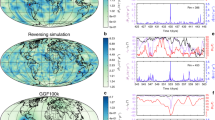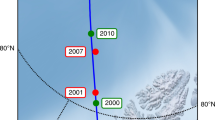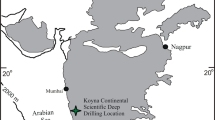Abstract
IT has long been thought that conditions at the boundary between the core and mantle influence the Earth's magnetic field, but the supporting evidence is rather indirect1–3. Recent palaeomagnetic results, suggesting that there are persistent preferred longitudinal paths for the virtual geomagnetic pole (VGP) during reversals4, would provide the first direct evidence of the solid mantle's influence on the core, although their statistical significance has been disputed5,6. The results are potentially exciting because the preferred paths lie close to the Pacific rim, where the present geomagnetic secular variation changes character2,7. Here we present a simple model, based on an extension of a previous theory8, that produces reversals with VGP paths confined within relatively narrow longitude bands despite the transition field having a substantially non-dipolar structure. Thus, although longitude bias of the VGP paths is definitive evidence for core-mantle interaction, simple VGP paths are not evidence of near-dipolar transition fields.
This is a preview of subscription content, access via your institution
Access options
Subscribe to this journal
Receive 51 print issues and online access
$199.00 per year
only $3.90 per issue
Buy this article
- Purchase on Springer Link
- Instant access to full article PDF
Prices may be subject to local taxes which are calculated during checkout
Similar content being viewed by others
References
Merrill, R. T. & McElhinny, M. W. The Earth's Magnetic Field (Its History, Origin and Planetary Perspective) (Academic, London, 1983).
Bloxham, J. & Gubbins, D. Nature 317, 777–781 (1985).
Jacobs, J. A. Reversals of the Earth's Magnetic Field (Hilger, Bristol, 1984).
Tric, E. et al. Phys. Earth planet. Int. 65, 319–336 (1991).
Valet, J.-P., Tucholka, P., Courtillot, V. & Meynadier, L. Nature 356, 400–407 (1992).
Laj, C., Mazaud, A., Weeks, R., Fuller, M. & Herrero-Bervera, E. Nature 359, 111–112 (1992).
Laj, C., Mazaud, A., Weeks, R., Fuller, M. & Herrero-Bervera, E. Nature 351, 447 (1991).
Gubbins, D., Nature 326, 167–169 (1987).
Hoffman, K. A. Nature 359, 789–794 (1992).
Langereis, C. G., van Hoof, A. A. M. & Rochette, P. Nature 358, 226–230 (1992).
Gubbins, D. Eos 72, 132 (1992).
Hoffman, K. A. Nature 309, 90–91 (1984).
Runcorn, K. Nature 356, 654–656 (1992).
Gubbins, D. & Roberts, N. Geophys. J. R astr. Soc. 73, 675–687 (1983).
Gubbins, D. & Bloxham, J. Nature 325, 509–511 (1987).
Constable, C. G. Nature 358, 230–233 (1992).
Author information
Authors and Affiliations
Rights and permissions
About this article
Cite this article
Gubbins, D., Coe, R. Longitudinally confined geomagnetic reversal paths from non-dipolar transition fields. Nature 362, 51–53 (1993). https://doi.org/10.1038/362051a0
Received:
Accepted:
Published:
Issue Date:
DOI: https://doi.org/10.1038/362051a0
This article is cited by
-
Small-scale structure of the geodynamo inferred from Oersted and Magsat satellite data
Nature (2002)
-
Analysis of a lower jurassic geomagnetic reversal based on a model that relates transitional fields to variations of flux on the core surface
Studia Geophysica et Geodaetica (1995)
-
Geomagnetic field morphologies from a kinematic dynamo model
Nature (1994)
-
Absence of preferred longitude sectors for poles from volcanic records of geomagnetic reversals
Nature (1993)
-
Persistent patterns in the geomagnetic field over the past 2.5 Myr
Nature (1993)
Comments
By submitting a comment you agree to abide by our Terms and Community Guidelines. If you find something abusive or that does not comply with our terms or guidelines please flag it as inappropriate.



